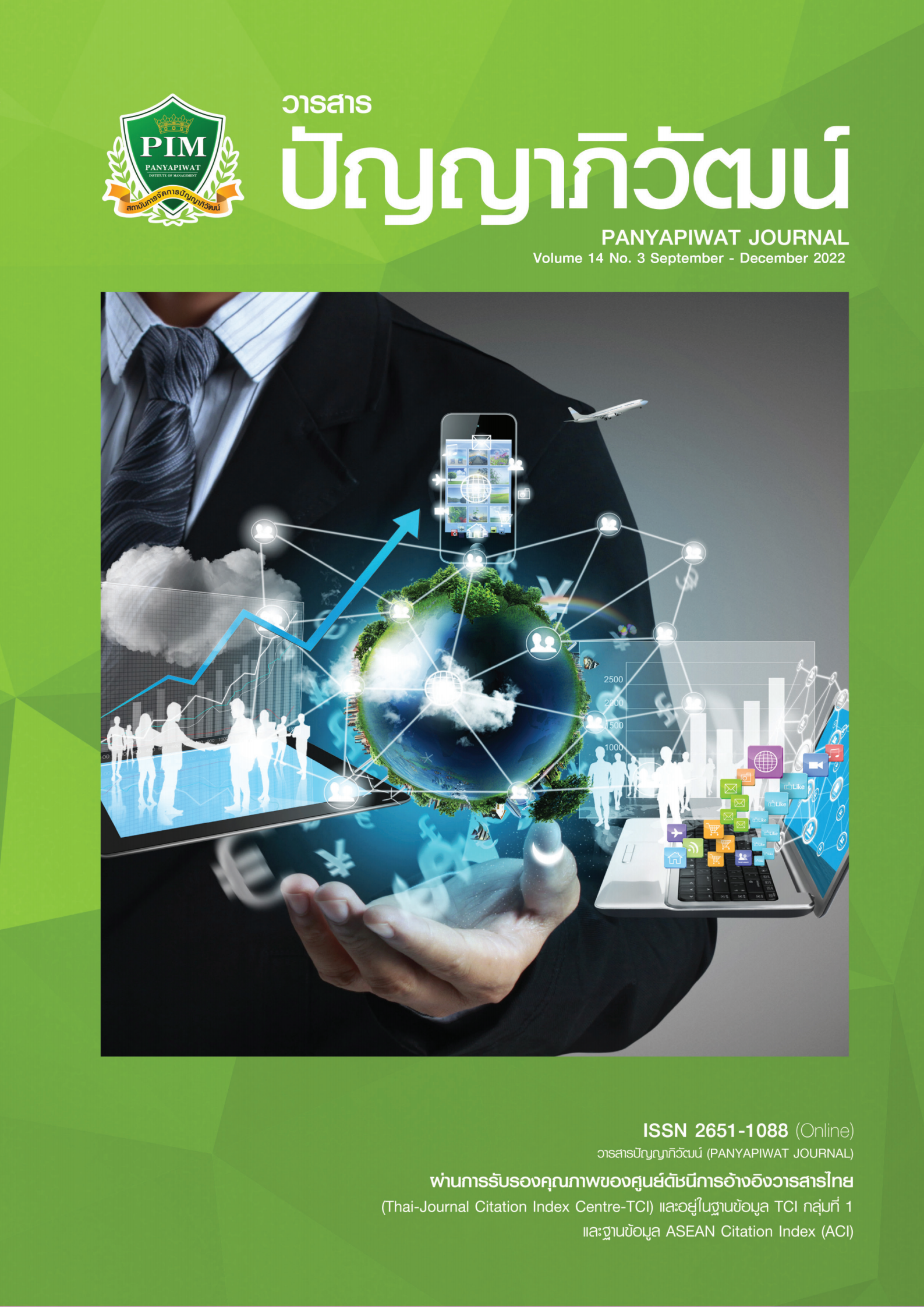สมรรถนะโลจิสติกส์ กลยุทธ์การจัดการโลจิสติกส์ และประสิทธิภาพโลจิสติกส์ ที่มีต่อผลการดำ เนินงานโลจิสติกส์ของอุตสาหกรรมผู้ผลิตชิ้นส่วนยานยนต์ในประเทศไทย
Main Article Content
บทคัดย่อ
บทความนี้มุ่งเน้นศึกษาระดับของสมรรถนะโลจิสติกส์ กลยุทธ์การจัดการโลจิสติกส์ ประสิทธิภาพโลจิสติกส์ และผลการดำเนินงานโลจิสติกส์ และตรวจสอบความสอดคล้องของแบบจำลองปัจจัยเชิงสาเหตุที่มีต่อผลการดำเนินงาน โลจิสติกส์ทั้งทางตรงและทางอ้อมของอุตสาหกรรมผู้ผลิตชิ้นส่วนยานยนต์ในประเทศไทย พื้นที่เป้าหมายคือ กลุ่มอุตสาหกรรมผู้ผลิตชิ้นส่วนยานยนต์ในประเทศไทย เครื่องมือการวิจัยเชิงปริมาณใช้แบบสอบถามเก็บรวบรวมข้อมูลจากกลุ่มตัวอย่างที่เป็นผู้บริหารองค์การจำนวน 417 ราย (อัตราการตอบกลับ 83.40%) มีค่าความเชื่อถือรวมเท่ากับ 0.989 และมีค่าการตรวจสอบความเที่ยงตรงของเนื้อหาจากผู้เชี่ยวชาญ เท่ากับ 0.917 อธิบายลักษณะแบบจำลองสมการโครงสร้างและผลศึกษาพบว่า ตัวแปรและองค์ประกอบทุกด้านมีค่าเฉลี่ยอยู่ในระดับมาก ความสัมพันธ์เชิงสาเหตุมีความสอดคล้องกลมกลืนกับข้อมูลเชิงประจักษ์ในเกณฑ์ดีมาก ผลการทดสอบสมมติฐานพบว่า สมรรถนะ โลจิสติกส์มีอิทธิพลทางอ้อมต่อผลการดำเนินงานโลจิสติกส์ผ่านประสิทธิภาพโลจิสติกส์ สมรรถนะโลจิสติกส์มีอิทธิพลทางตรงต่อกลยุทธ์การจัดการโลจิสติกส์และประสิทธิภาพโลจิสติกส์ และประสิทธิภาพโลจิสติกส์มีอิทธิพลทางตรงต่อผลการดำเนินงานโลจิสติกส์
Article Details

อนุญาตภายใต้เงื่อนไข Creative Commons Attribution-NonCommercial-NoDerivatives 4.0 International License.
“ข้าพเจ้าและผู้เขียนร่วม (ถ้ามี) ขอรับรองว่า บทความที่เสนอมานี้ยังไม่เคยได้รับการตีพิมพ์และไม่ได้อยู่ระหว่างกระบวนการพิจารณาลงตีพิมพ์ในวารสารหรือแหล่งเผยแพร่อื่นใด ข้าพเจ้าและผู้เขียนร่วมยอมรับหลักเกณฑ์การพิจารณาต้นฉบับ ทั้งยินยอมให้กองบรรณาธิการมีสิทธิ์พิจารณาและตรวจแก้ต้นฉบับได้ตามที่เห็นสมควร พร้อมนี้ขอมอบลิขสิทธิ์บทความที่ได้รับการตีพิมพ์ให้แก่สถาบันการจัดการปัญญาภิวัฒน์หากมีการฟ้องร้องเรื่องการละเมิดลิขสิทธิ์เกี่ยวกับภาพ กราฟ ข้อความส่วนใดส่วนหนึ่งและ/หรือข้อคิดเห็นที่ปรากฏในบทความข้าพเจ้าและผู้เขียนร่วมยินยอมรับผิดชอบแต่เพียงฝ่ายเดียว”
เอกสารอ้างอิง
Aphiprachayasakul, K. (2020). Logistics and supply chain management “Strategies to make rich helps to save”. Focus Media Publishing. [in Thai]
Barney, J. B., Ketchen, D. J., & Wright, M. (2011). The future of resource-based theory: Revitalization or decline? Journal of Management, 37(5), 1299-1315.
Bihter, K., & Ali, E. A. (2015). The roles of IT capability and organizational culture on logistics capability and firm performance. Journal of Business Studies Quarterly, 7(2), 23-45.
Chim-Jiew, S. (2020). Logistics management of the auto industry for the duration of the COVID-19 outbreak [Master’s thesis]. Ramkhamhaeng University. [in Thai]
Comrey, A. L., & Lee, H. B. (1992). A first course in factor analysis (2nd ed.). Lawrence Erlbaum Associated.
Division of Logistics, Department of Industrial Promotion (DIPROM), Ministry of Industry and Small and Medium Industrial Institute (SMI), The Federation of Thai Industrial. (2018). Handbook of logistics management and the preparation of a roaming workshop. DIPROM. [in Thai]
Eastern Economic Corridor (EEC). (2018). The automotive industry of the future. https://www.eeco.or.th/industry/
Gallon, M. B., Stillman, H. M., & Coates, D. (1995). Putting core competency thinking into practice. Research Technology Management, 38(3), 20-28.
Hair, J., Black, W., Babin, B., Anderson, R., & Tatham, R. (2006). Multivariate data analysis (6th ed.). Pearson Prentice Hall.
Hair, J. F., Hult, G. T., Ringle, C. M., & Sarstedt, M. A. (2017). Primer on Partial Least Squares Structural Equation Modeling (PLS-SEM). Prentice Hall.
Industrial Estate Authority of Thailand (IEAT). (2020). Member-list, group of auto parts manufacturers in Thailand. https://www.ieat.go.th/ieat-industry-port-factory/ieat-factory-search [in Thai]
Jones, G., George, J., & Hill, C. (2000). Contemporary management. Irwin MacGraw Hill.
Kanitpong, T. (2018). Competitiveness of Thailand’s electric vehicle industry. NIDA Business Journal, (23), 5-19. [in Thai]
Kline, R. B. (2011). Principles and practice of structural equation modeling (3rd ed.). The Guilford Press.
Lu, C. S., & Yang, C. C. (2010). Logistics service capability and firm performance of international distribution center operators. The Service Industries Journal, 30(2), 281-298.
Ministry of Industry (Thailand). (2016). Thailand industrial development strategy 4.0 (2017-2036).
Nulty, D. D. (2008). The adequacy of response rates to online and paper surveys: What can be done? Assessment & Evaluation in Higher Education, 33(3), 301-314.
Pisitkasem, P. (2014). Determinants of logistics capability and its effects on the performance of the auto parts manufacturing industry in Thailand [Doctoral dissertation]. Ramkhamhaeng University. [in Thai]
Sakvanichkul, P. (2018). The efficiencyof logistics services for machine toolsand metalworking technology exhibition [Doctoral dissertation]. Silpakorn University. [in Thai]
Thai Autoparts Manufacturers Association (TAPMA). (2020). Member-lists. http://www.thaiautoparts.or.th/index.php?op=member-index [in Thai]
The Thai Automotive Industry Association (TAIA). (2020). Member-lists. https://taia.or.th/taia-information/member-lists/ [in Thai]
West, P. G., & Bamford, C. E. (2010). Strategy: Sustainable advantage and performance. South-Western, Cengage Learning.
Wijititkulsawat, N. (2018). Logistics management strategy 4.0 with self-adjustment for Thai entrepreneurs in industrial era 4.0. https://tdc.thailis.or.th/tdc/dccheck.php?Int_code=52&RecId=31858&obj_id=200277&showmenu=no&userid=0 [in Thai]
Zawawi, N. F. B. M., Sazali, A. W., Abdullah, A. M., Ahmad, G. B., & Fazal, S. A. (2017). Logistics capability, information technology, and innovation capability of logistics service providers: Empirical evidence from East Coast Malaysia. International Review of Management and Marketing, 7(1), 326-336.


